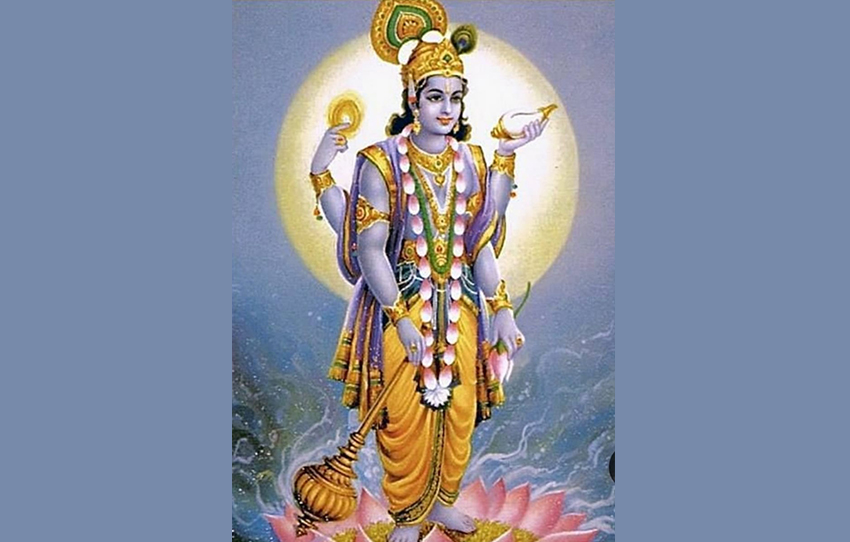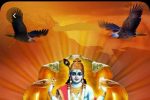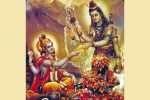NAME 37
Svayaṁbhūḥ स्वयंभूः
He has manifested on His own. He was not created by anyone else. He is the cause for creation and there is no cause for His creation. He created Himself. This is yet another quality of the Brahman. He is ādhi (first) and anādhi (without parentage).
३७. ॐ स्वयम्भुवे नमः।
37. Om Svayaṁbhūḥvey Namah
Svayambhooh -The one who manifests Himself from Himself is considered as self-made. Everything born or produced must have a cause. The Supreme is the cause from which all effects arise, and Itself has no cause. This un- caused Cause-of-all, this Ultimate Cause, with reference to which every thing else is considered as ‘effects’ is in itself the Absolute Cause. This idea is indicated by the term Self-made (Svayambhooh)
The Lord Who Manifests from Himself.
INTERPRETATION GUIDED BY SANT VANI (WORDS OF SAINTS)
Svayaṁbhuḥ
The self-existent.
The one, who is self-existent, not created by anyone, but anadi, beginningless –Svayamevabhavatiitisvayaṁbhuḥ.
In India, many temples gain great fame and reverence because the deity whether Ganapati or Shivalinga are said to be svayambhuh, independently existing. The stones were found to be shaped in a particular form of the deity as mentioned in the Puranas. They did not need to be sculpted before consecration in the temple.
When we look around, everything else is created and everything has a dependence on something else for its existence. A shirt did not spring into existence. It depends on the fabric for its existence, whereas the fabric does not depend on the shirt. But, the fabric also is not independent.
It is paratantra, dependent on something else, the yarn. The yarn depends on the fibres, the fibres dependent on molecules, the molecules depend on atoms, the atoms on particles and the particles in turn are dependent on knowledge. Knowledge is dependent on the consciousness. Thus we find that everything is paratantra, dependent on something else for its existence.
Even the different identities that we have built up are based on the roles we play – mother, father, sister, brother, son, partner, employee, student etc depend on the person, a conscious being. The person is independent of the roles. Roles are dependent on the person. The person needs to be there before the roles are picked up. Often, the person is disregarded, as the role, that dependent entity is taken to be real. It is this simple person that relates to the total, Isvara. In awareness of the total, that self existent, Svayambhuh, the person can relax as the sense of isolation, alienation and loneliness start to fade away. He is svatantra, not dependent on anything, and can certainly be depended upon.
Isvara is Svayambhuḥ, because His atma is svayambhuḥ. As satyamjñanaṁ, it is the atma of everything. So the caitanya, consciousness, is the satya, which svayaṁevabhavati, exists by itself without depending on anything else for its existence.
Svayamevabhavatiitisvayambhuh – He himself has become everything, manifests as everything because He has created everything out of himself.
Atha vasvay ambhuh parames varahsva yamevas vatantrah bhavatiiti–or else, as Parameśvara, Even maya is not created. It is anadi, but is paratantra, being dependent on Brahman.
This is a journey from Swayam to Swayambhu….as you are self existing without labels.
Please watch to understand the deeper essence of the Name.
There are eight self-manifested temples of Vishnu.
The belief is that SriHari Vishnu appeared here and the main murti worshipped in the temple is of divine origin. The temples are known as Swayam VyaktaKshetras or Swayambhu temples.
The eight temples are:
- Sri Ranganathaswamy Temple at Srirangam
This is the most important shrine among the eight temples. At Sri Ranganathaswamy Temple (Thiruvarangam), Bhagavan Vishnu is worshipped as Ranganatha, a reclining form of the Hindu deity Vishnu. The shrine is located in Srirangam, Tiruchirapalli, Tamil Nadu, India.
- Tirupati Balaji Temple, Tirumala
- Bhoovaraha Swamy Temple in Sri Mushnam at Cuddalore
- Vanamamalai Perumal Temple, also known as Sri Thothadri Nathan temple or Sri Vara Mangai, near Tirunelveli.
- Salagramam Temple in Nepal
At the Gandaki River in Nepal Vishnu takes the form of Salagrama Stone
- Varaha Temple in Pushkar
- Naimisharanya in Uttar Pradesh.
This is a holy spot where Brahma asked saints to reside and spread the teachings of Sanatana Dharma.
- Badrinath Temple in Uttarakhand.



